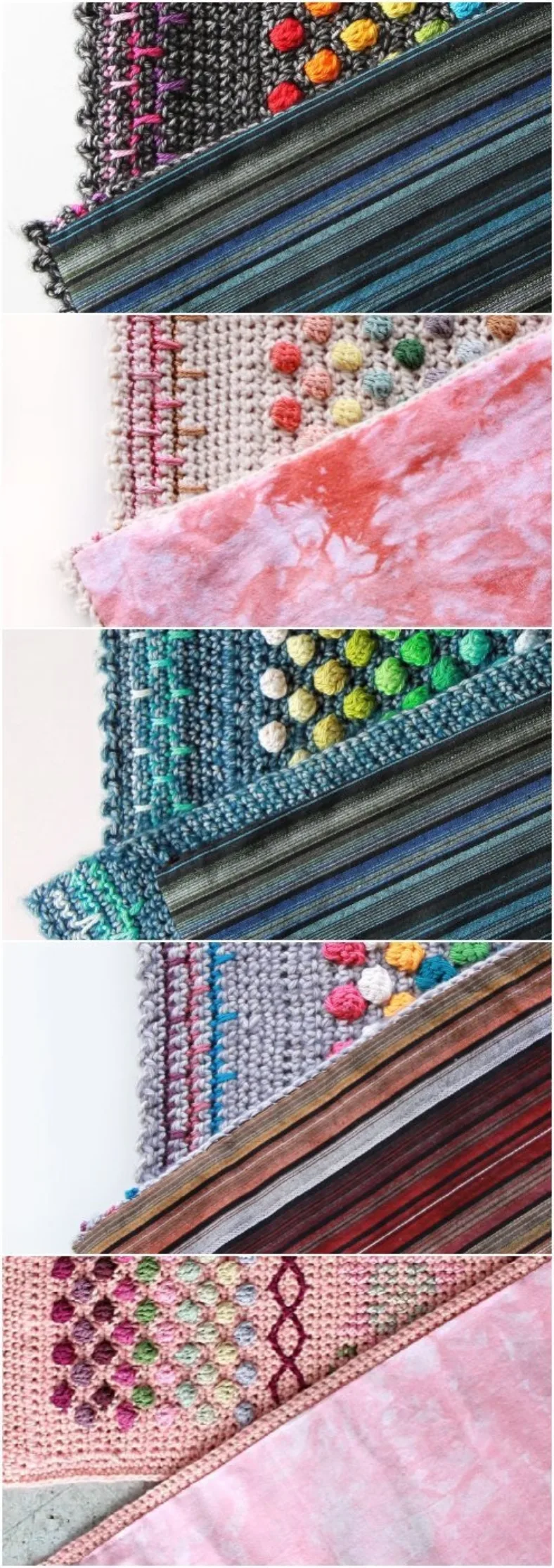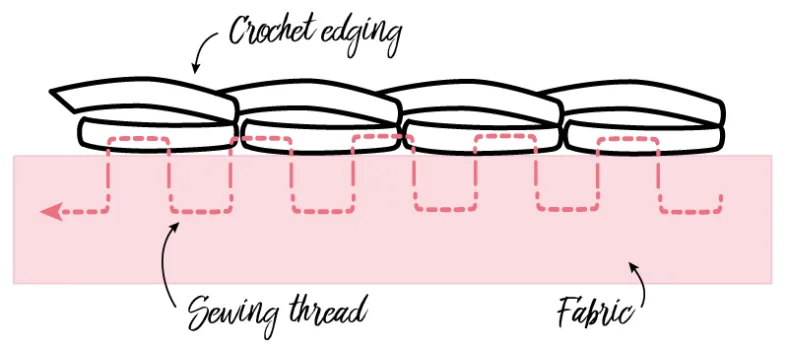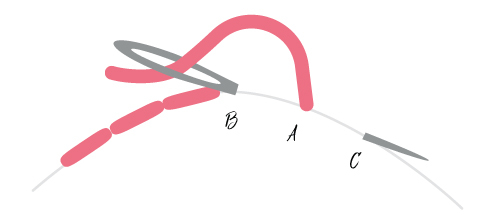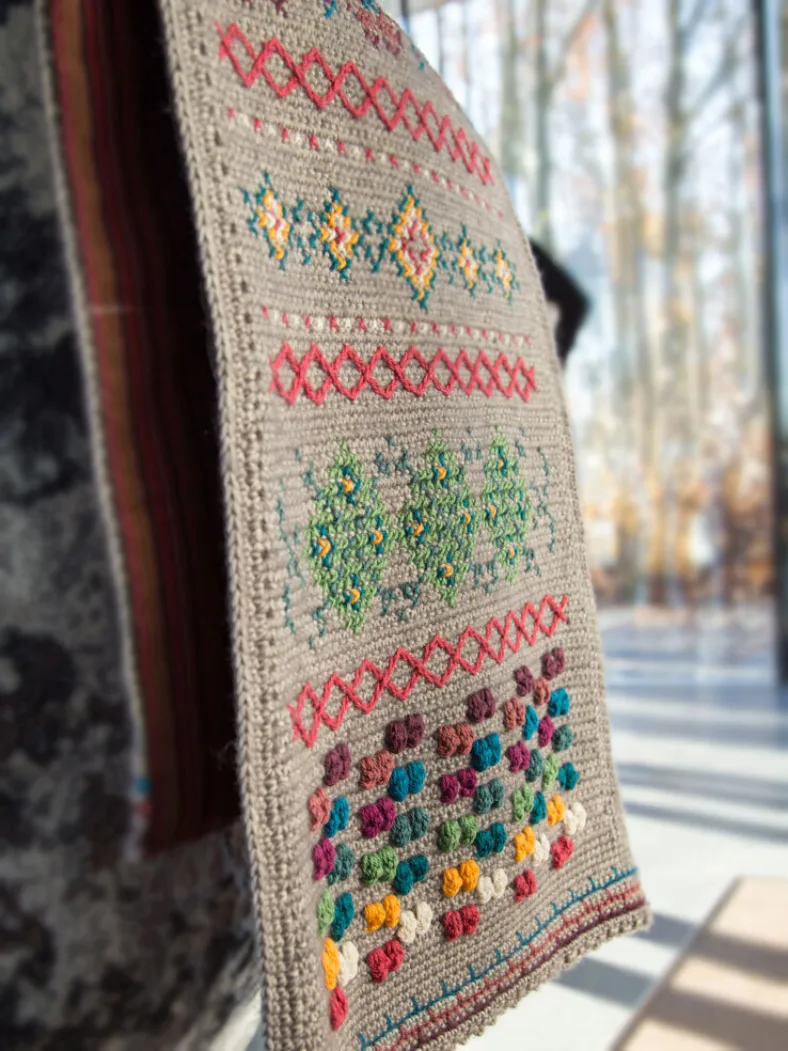Hygge shawl (Part 14)
03.Oct.24 / Kirsten BalleringHygge is a Danish word that roughly translates to cosiness, but it’s much more! It’s about cosiness and being in a warm, welcoming environment and enjoying the good things in life. Being with friends and family is hygge. But wearing your favourite sweater with a cup of tea is hygge, too. And working on a cosy wrap, learning new things, and enjoying the process is definitely hygge.
Shop the yarn!
Do you want to get your hands on Stonewashed and Catona? Shop them through the links below:
Crochet hook
4.5mm hook (US size G/7).
Measurements
Blocked shawl measures 185 x 36cm (73 x 14in).
Gauge/tension
See Part 1 for gauge instructions.
Notes
- If you find it hard to keep track of the rows, take a contrast yarn and weave that horizontally through your rows on the top and bottom. When you finish, take your contrast yarn out.
- The bobbles are worked on the opposite side of the shawl as compared to part 1. Make sure to pop them to the front of your shawl before finishing!
- The row numbers in purple[purple] indicate the row count when you count the rows continuously throughout the parts.
- The other pattern parts of the Hygge shawl can be found here:
Abbreviations (US terms)
- ch: chain
- sc: single crochet
- bobble: (yarn over, pull up loop, yarn over, pull through 2 loops on hook) 5 times, yarn over, pull through all loops on hook
- st(s): stitch(es)
- RS: Right side
- WS: Wrong side
Repeat formats
- *….; rep from * once/twice/3x Crochet the instructions after * and then repeat that section a further number of times as indicated.
- (…) once/twice/3x Crochet the instructions between brackets the total number of times indicated.
- […] Indicates the amount of stitches at the end of a row or round.
- (…) in same st/sp Indicates that all instructions between brackets are worked in the same stitch or space.
Colour layout

Crochet pattern
Lining
Finally, you will line your shawl by hand! The method described is very straightforward and creates a (near) invisible hem stitch. There are multiple ways to line a shawl, and if you prefer another method, surely go ahead!
Materials
- 100% cotton fabric
- Optional: tacking thread
- Tailor chalk or washable fabric marker
- Fabric scissors
- Needle & thread (matching your SW colour)
Step 1: Washing
If you use 100% cotton fabric, some shrinkage will likely occur when you wash your shawl. For this reason, it’s recommended that the fabric be pre-washed. Remember that the shrinkage is on average 5% so account for this in the size of your fabric. After washing, iron the fabric.
Step 2: Tacking thread
Pre-lining the shawl with tacking thread is optional, but I highly recommend it. Tacking thread is easily breakable and acts as a placeholder to keep your fabric in place when you sew in the lining. It also makes it easier to put your project aside without shifting your fabric. You could also use quilting clips for this.
Please remember to keep an eye on the front of your shawl when you work with tacking thread. If your shawl looks bundled up in one place or isn’t lying flat when you turn your work, go back and re-do that part, as it will show in your final lining, too!
To pre-line your shawl, follow these steps:
- Lay your shawl flat and place your fabric on top of it. Trim the fabric to size; there should be ~2cm (¾in) of excess fabric on all sides.
- Start in the top right corner. Fold a 1.5cm (½in) seam between the shawl and your fabric. Gently press with an iron if necessary. You will stitch your lining in the last row’s stitches on all sides.
- Use a running stitch and stitch approx. ~0.5/1cm (¼in) from the edge of the fabric. Ensure you also stitch through the seam to keep it in place. Smooth your fabric and shawl with your hands as you go, making sure not to pull too hard on the fabric or shawl to prevent creasing or overstretching.
- When you reach the top left corner, gently smooth out your fabric and trim any excess fabric to size. Fold the side seam inwards. Continue stitching down the short side, adjusting the seam to accommodate your shawl size.
- Continue around the shawl. When you’ve stitched around, break off your tacking thread.
Step 3: Lining
Now, take a piece of sewing thread and thread your needle. Tie a knot at the end. On all sides, stitch the very edge of the fabric to the last row of stitches.
With your needle, pick up a small piece (~3mm/0.1in) of the bottom loop of your crochet stitch and pull it through. Next, insert your needle into the seam fold of the fabric and pick up a small piece (~3mm/0.1in), pulling the thread through. Don’t pull too tight.
Pick up the next small piece of crochet stitch and a bit of the next stitch. Continue like this all around the shawl, knot to the beginning thread and leave a 10cm (4in) tail to weave in.
Using this method, you barely see the sewing thread in the crochet stitch or fabric! For extra visuals, see the diagram.

Step 4: Vertical lines
Your fabric is secured on all sides, but you must secure it in the centre of your shawl, too, or it will sag down. To do so, you will make vertical lines through the fabric and the back of your shawl with a straightforward backstitch.
Measure out the middle of your shawl lining, and mark the vertical line (from the long side to the other long side of your shawl) with tailor chalk or a fabric marker.
Next, take a piece of sewing thread, tie a knot at the end and make short backstitches along the line. Backstitches are made by picking up a small piece of fabric (and shawl!) from point A to B (see graphic on next page), and pulling your thread through which will run at the backside of your fabric. Next, insert your needle ahead of point A in point C and pick up a small piece of fabric again. Try to pick up just enough of the shawl to get a sturdy stitch, but not show on the frontside of the shawl if possible.
Repeat this until you’ve finished stitching along the line. Divide each half of the shawl into halves again and repeat the process. Finally, divide each half in two again and repeat this. Pull out the tacking thread and sew in all loose ends. You’re done!

Caring for your shawl
It’s essential to take good care of your shawl. With proper maintenance, it will last a long time—this goes for all handmade items, of course.
Colour Catcher
Always use a colour catcher when you wash your shawl for the first time. The yarns used in this pattern are very colourfast, but there is always a small chance of colour bleeding. A colour catcher will ‘catch’ any excess dye and trap it, preventing it from running.
Washing
Wash the shawl, preferably by hand. Although cotton and acrylic don’t felt, the shawl and its embroidery will look best if the yarn is not overly agitated when washed. Choose a gentle cycle like wool wash if you can’t clean it by hand.
Drying
Always let your handmade item dry flat and in shape. Avoid the dryer as much as possible, as your yarn might get agitated and snag.
Pilling
It is possible that a little bit of pilling will occur when you’re wearing your Hygge shawl. Pilling results from friction and heat, and virtually every fibre will pill a little bit when used (check the armpits and sleeves of your favourite cardigan—you’ll probably find them there, too!).Pills are easily removed by using a bubble buster every once in a while. Regular washing will remove little pills, too. Over time, pilling usually gets a little bit less.





Comments
Be the first to comment to this post!